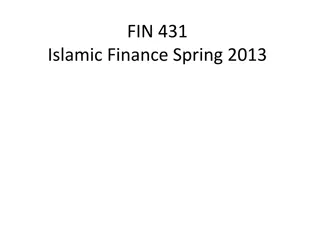
Financial Statement Analysis Methods and Techniques
Learn about financial statement analysis, including horizontal analysis, vertical analysis, dollar change analysis, and percent change analysis. Understand how these methods help in evaluating a business's financial stability, profitability, and solvency.
Download Presentation

Please find below an Image/Link to download the presentation.
The content on the website is provided AS IS for your information and personal use only. It may not be sold, licensed, or shared on other websites without obtaining consent from the author. If you encounter any issues during the download, it is possible that the publisher has removed the file from their server.
You are allowed to download the files provided on this website for personal or commercial use, subject to the condition that they are used lawfully. All files are the property of their respective owners.
The content on the website is provided AS IS for your information and personal use only. It may not be sold, licensed, or shared on other websites without obtaining consent from the author.
E N D
Presentation Transcript
PrinciplesofAccounting II Lesson #5 Financial Statement Analysis By Laurie L. Swanson Nashville State Community College Click the button below to navigate to the next slide. Arrow Button Arrow button to proceed to next slide.
Financial Statement Analysis The process of analyzing businesses to determine if the business is financially stable, solvent, and profitable. Arrow Button Arrow button to proceed to next slide.
Horizontal Analysis Comparison of income statements or balance sheets to determine both dollar change and percent change. The comparison may be between accounting periods within the same company or between competitor companies. Arrow Button Arrow button to proceed to next slide.
Dollar Change Analysis Dollar change analysis is horizontal analysis in which the amount of dollar change is calculated between the analysis period (usually the current period) and the base period (the beginning point used for comparison purposes). Dollar Change = Analysis Period Amount Base Period Amount Arrow Button Arrow button to proceed to next slide.
Percent Change Analysis Percent change analysis is horizontal analysis in which the change is calculated as a percentage of the base period. Financial statements prepared in percents are also known as common-size financial statements. Preparing common-size financial statements provides for more accurate data comparison by using a common base. Percent Change = (Analysis Period Amount Base Period Amount) Base Period Amount X 100 Arrow button to proceed to next slide.
Vertical Analysis Vertical analysis is used to assess individual items on financial statements as a proportion of a specific base amount. Vertical analysis is most frequently used in the preparation of common-size financial statements. Arrow button to proceed to next slide.
Common-Size Financial Statements Financial statements in which each item is shown as a percent of a whole are known as common-size financial statements. Preparing common-size financial statements provides for more accurate data comparison by using a common base and helps to emphasize the relative importance of each item on the financial statement out of the base. Common-size percent = (Analysis Amount/Base Amount) X 100. Arrow button to proceed to next slide.
Common-Size Financial Statements When preparing common-size income statements, the base is Net Income. When preparing common-size balance sheets, the base is Total Assets. The base amount is always shown as 100% in common size statements. Arrow button to proceed to next slide.
Example of Common-Size Balance Sheet Below is an example of a common-size balance sheet based on data from Exercise 17-7 (2014) in your Fundamental Accounting Principles text. Both the dollar value and percent are shown in the example as well as the calculation of the percentage. Notice that each line item is calculated as a percentage of total assets and that total assets (the base) is shown as 100%. Sanderson Company Common-Size Balance Sheet December 31, 2014 Dollar ValueCommon- Calculations Size Assets Cash Accounts receivable, net Merchandise inventory Prepaid expenses Plant assets, net Total assets Liabilities and Equity Accounts payable Long-term notes payable secured by mortgages on plant assets Common stock, $10 par value Retained earnings 31,800 89,500 112,500 10,700 278,500 $523,000 6.1% 17.0 21.5 2.1 53.3 100.0% ($31,800/$523,000) X 100 ($89,500/$523,000) X 100 ($112,500/$523,000) X 100 ($10,700/$523,000) X 100 ($278,500/$523,000) X 100 ($523,000/$523,000) X 100 129,900 24.9% ($128,900/$523,000) X 100 98,500 18.8 ($97,500/$523,000) X 100 163,500 131,100 31.3 25.0 ($162,500/$523,000) X 100 ($129,100/$523,000) X 100 Arrow button to proceed to next slide. Total liabilities and equity $523,000 100.0% ($518,000/$523,000) X 100
Ratio Analysis Ratio analysis is one of the most valuable tools in financial analysis. Ratios are calculated using data from financial statements. Various ratios can be computed to provided data on a company s liquidity, solvency, profitability, and market prospects. Having financial data in ratio format makes comparisons within a company as well as between companies more meaningful. Arrow button to proceed to next slide.
Ratio Analysis: Formulas and Interpretations See page 705 of you textbook for the formulas used for common ratio calculations. Information on interpreting the ratios can be found in the Ratio Analysis section of Chapter 17 of your text as well as on the Ratio Analysis handout attached to Lesson 5. Arrow button to proceed to next slide.
End of Lesson 5 Presentation Financial Statement Analysis By Laurie L. Swanson




















